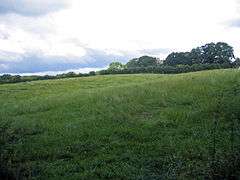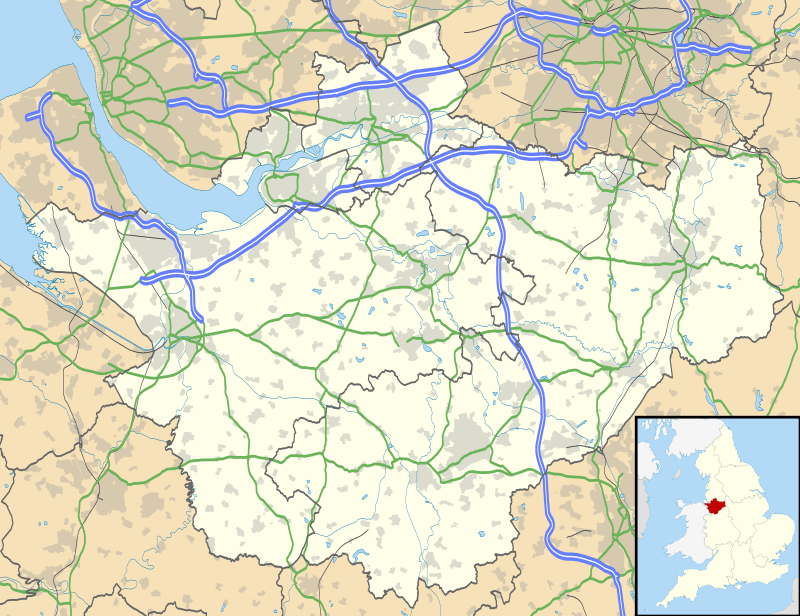Kelsborrow Castle
Kelsborrow Castle is an Iron Age hill fort in Cheshire, northern England. Hill forts were fortified hill-top settlements constructed across Britain during the Iron Age. It is one of only seven hill forts in the county of Cheshire and was probably in use for only a short time. In the 19th century, a bronze palstave was recovered from the site.[1] It is protected as a Scheduled Ancient Monument.[2][3]
| Kelsborrow Castle | |
|---|---|
 The former ramparts of Kelsborrow Castle | |
 Location within Cheshire | |
| General information | |
| Architectural style | Iron Age hillfort |
| Country | England |
| Coordinates | 53.2034°N 2.702097°W |
| Technical details | |
| Size | 9 acres (4 ha) |
Background
Hill forts developed in the Late Bronze and Early Iron Age, roughly the start of the first millennium BC.[4] The reason for their emergence in Britain, and their purpose, has been a subject of debate. It has been argued that they could have been military sites constructed in response to invasion from continental Europe, sites built by invaders, or a military reaction to social tensions caused by an increasing population and consequent pressure on agriculture. The dominant view since the 1960s has been that the increasing use of iron led to social changes in Britain. Deposits of iron ore were located in different places to the tin and copper ore necessary to make bronze, and as a result trading patterns shifted and the old elites lost their economic and social status. Power passed into the hands of a new group of people.[5] Archaeologist Barry Cunliffe believes that population increase still played a role and has stated "[the forts] provided defensive possibilities for the community at those times when the stress [of an increasing population] burst out into open warfare. But I wouldn't see them as having been built because there was a state of war. They would be functional as defensive strongholds when there were tensions and undoubtedly some of them were attacked and destroyed, but this was not the only, or even the most significant, factor in their construction".[6]
Location
Although there are over 1,300 hill forts in England, they are concentrated in southern England, and there are only seven in Cheshire.[7] Along with Eddisbury and Oakmere, Kelsborrow forms a small cluster of Iron Age hill forts within 3 miles (5 km) of each other, near the Mouldsworth Gap, a break in the central ridge that runs north–south through Cheshire. The hill forts at Eddisbury and Oakmere lie to the north-east and east respectively.[8] Kelsborrow Castle is located at grid reference SJ53176752, 400 ft (120 m) above sea level. The site overlooks the Cheshire Plain to the west, south-west, and south. There is high ground immediately to the east of Kelsborrow Castle, rising to a height of 500 ft (150 m).[9]
Layout
As well as being a hill fort, Kelsborrow Castle is a type of promontory fort, as it exploits the natural steep slopes of the area to create a defensive site.[1] The site is surrounded by an artificial bank and ditch, although there is a gap in the ditch for around 400 ft (120 m) in the west. This is probably because the ground slopes sharply away where there is no ditch.[9] The best surviving parts of the bank are 6 ft (1.8 m) high, and the distance between the outer edge of the ditch and the inner edge of the rampart is 100 ft (30 m).[9] The defences cover 1.75 acres (0.71 ha), and enclose an area of 7.25 acres (2.93 ha).[10] The entrance of the fort is probably in the south-east.[2] Multivallate (more than one series of earthworks) forts are common in southern England; that Kelsborrow Castle is single vallate (i.e. it has only one ditch and bank) means it is probably a one-phase site, indicating it would only have been used for a short time.[11] The hill fort is similar in typology to the hill forts at Bradley, and Oakmere, in Cheshire, and Castercliff and Portfield in Lancashire.[11]
Preservation and current state
Geophysical surveys and small-scale archaeological excavations in 1973 and 1996 indicated that there may be structures such as storage pits buried within the hill fort. The site is part of wider agricultural land and suffers erosion from vehicles and livestock movement. Animal burrows and the spread of bracken also pose a threat to the site. Although the site is designated as "at low risk", a more recent survey has suggested changing it to "at high risk" because of activities such as ploughing at Kelsborrow Castle.[12] Five of the hill forts in Cheshire have been assessed as being "at high risk" compared to 15% of North West England's Scheduled Monuments.[13]
See also
- Scheduled Monuments in Cheshire (pre-1066)
References
Citations
- Kelsborrow promontory fort on Castle Hill, Cheshire.gov.uk, retrieved 2009-03-26
- Kelsborrow Castle, Pastscape.org.uk, retrieved 2009-03-26
- Historic England, "Kelsborrow promontory fort on Castle Hill 300m south west of Castle Hill Farm (1013294)", National Heritage List for England, retrieved 1 December 2012
- Payne, Corney, & Cunliffe (2007), p. 1.
- Sharples (1991), pp. 71–72.
- Time Team: Swords, skulls and strongholds, Channel 4, 2008-05-19, retrieved 2009-06-16
- Forde-Johnston (1962), pp. 13–14.
- Forde-Johnston (1962), p. 14.
- Forde-Johnston (1962), p. 20.
- Forde-Johnston (1962), p. 21.
- Forde-Johnston (1962), p. 45.
- Archaeological management issues: Kelsborrow Castle, Habitats & Hillforts Landscape Partnership Scheme, archived from the original on 25 March 2011, retrieved 2009-07-09
- Archaeological management issues, Hillforts, archived from the original on 25 April 2012, retrieved 2009-07-05
Sources
- Forde-Johnston, James (1962), "The Iron Age Hillforts of Lancashire and Cheshire", Transactions of the Lancashire and Cheshire Antiquarian Society, 72: 9–46
- Payne, Andrew; Corney, Mark; Cunliffe, Barry (2007), The Wessex Hillforts Project: Extensive Survey of Hillfort Interiors in Central Southern England, English Heritage, ISBN 978-1-873592-85-4
- Sharples, Niall M (1991), English Heritage Book of Maiden Castle, London: B. T. Batsford, ISBN 0-7134-6083-0